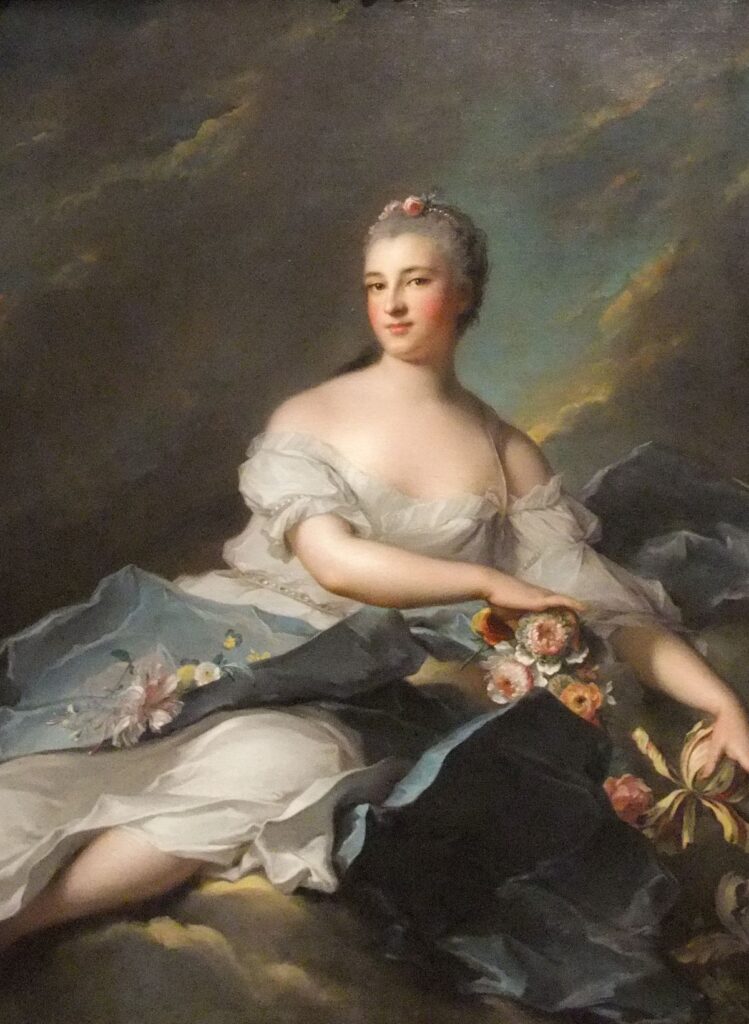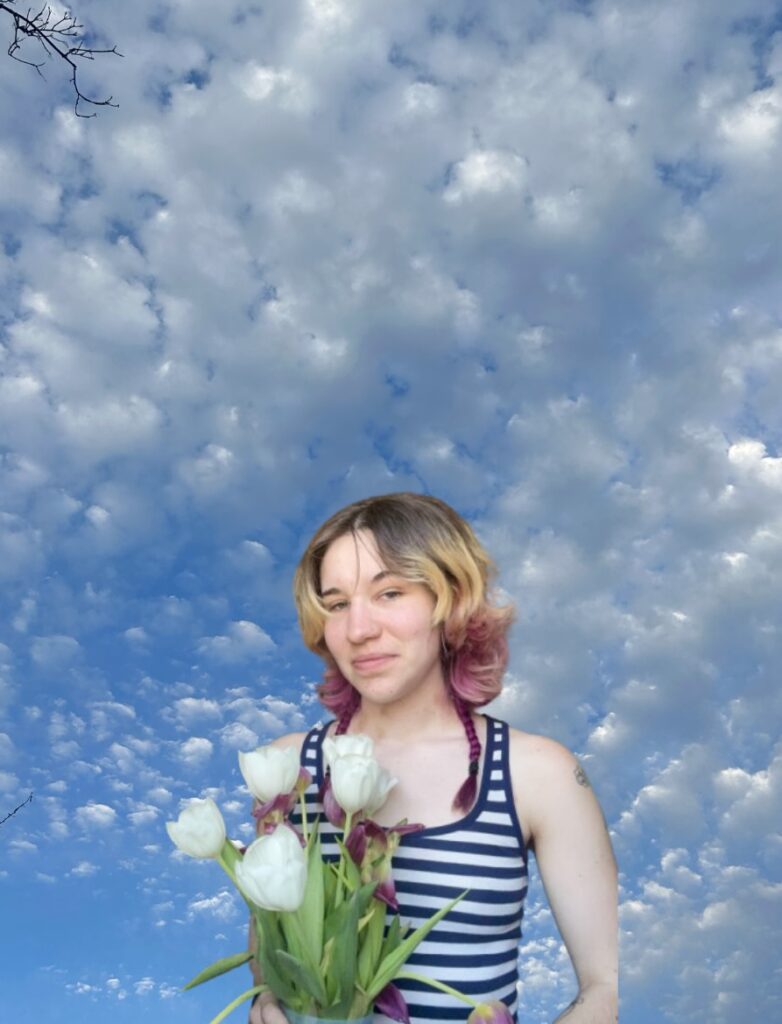
Elisabeth Rigoley d’Ogny as Aurora, a painting by Jean-Marc Nattier, is a depiction of a noblewoman dressed as the Roman goddess of the dawn. It hangs in the Baltimore Museum of Art, a museum which I visited many times as a child. This painting, and countless other paintings, capture ideals of femininity that still prevail today. Now more than ever, there is no one way to be feminine, yet paintings such as this one have ingrained images into our heads that are hard to break away from. As a queer nonbinary person, I don’t often feel represented in museums. This has definitely changed more with modern art, but walking through museums like the Baltimore Museum of Art which mostly feature older art, the ideals of femininity expressed there do not feel representative to me. I wanted to find a way to remix a painting in a way that would showcase a different expression of femininity that was true to me. I chose this painting after looking at a selection from the Baltimore Museum of Art’s website because it was overall a pretty simple composition, and when I started out, I was planning to recreate the composition more exactly. I also chose it because I liked the connection that it showed with nature.
Ultimately, I chose not to follow the composition exactly because to me, that does not feel like the point of a remix. It should be something that feels like I created it, and copying something almost exactly, even if I look nothing like the woman in the picture, would not have felt like a true remix. Another facet in completing this project was that I don’t often like photos of myself, and I wanted to create something where I could feel beautiful. Having to pose myself and make the picture feel extremely stiff didn’t feel like it would achieve this goal. I felt it was important for me to feel relaxed in order to feel more happy with the final piece. I also made the other elements of the composition things that felt meaningful to me: one of my favorite shirts, flowers that I got from my girlfriend after a recent show I was on crew for, and an image of the sky that I took during my time at Smith. At completion, there is very little about the original and the remix that feel the same, but I believe that that is the point, and that I did capture some of the essence of the original. I am not the woman in the picture and I will never be her, and that is what I want. She is beautiful and so am I.
As this painting was created hundreds of years ago, I cannot begin to imagine how Elisabeth Rigoley d’Ogny felt as she was being painted. I can only think of how uncomfortable I would be in this situation, as I feel there is something different about a woman captured by a man and a woman captured by herself in art. Although to me this piece specifically does not feel like it is objectifying the subject, this is something that often happens in art. Women have long been exploited by men for the sake of art, and this is unfair and incredibly harmful. I have found no such details about this piece, yet that idea is something that overshadows all art. Additionally, especially in the past, many well known portrait painters – and artists in general – were men, as many less opportunities were available to women. It is impossible to go back in time and make these opportunities possible, but encouraging women and marginalized communities to create art that represents themselves is incredibly important moving forward.
In a world so convoluted with reused ideas, being original becomes increasingly difficult. What defines originality continues to grow and change, but my personal definition of it is applying your own experience and identity to your artistic endeavors, even if you are reusing some ideas. Originality does not have to be a completely new idea, as this is nearly impossible at this point in time, but there is definitely an important distinction between remixing and copying. When copying, you are not adding anything new or of your own.
In this case, originality applies to remixing because it involves applying your own identity to something. The importance of remixing comes when artistic pieces have outdated ideas or do not apply to or misrepresent your identity. Often there is the experience of having art that you love, but that does not fit your personal identity, and that can sometimes be hurtful. Remixing provides an avenue to utilize your own creativity while still incorporating ideas that you love. Remixing can also function as a form of critique because it can highlight the ideas in a piece of art that are outdated or dismissive. Seeing a remix and an original side by side displays their differences and captures what the artist creating the remix sees as things that need to be changed. I don’t know if my piece serves as a particularly strong example of critique through remix, as I’m not sure if the ideas I’m trying to express are obvious to someone who does not know me or that I have not been able to explain this to. Without seeing the two pieces side by side, it may not be clear that one is a remix of the other at all.
In creating my picture, I thought a lot about what needed to be taken from something to be considered a remix. As I stated before, I initially wanted to create something that was much more similar to the original, but this is not the direction I ended up following. What I realized is that even if the two pieces don’t look very alike, I wouldn’t have had the idea for my piece without examining Elisabeth Rigoley d’Ogny as Aurora and the idea is the core of the piece. I also don’t think that the visual similarities are the most important part. Although this is a visual art assignment, many of the things that I feel are remixed come from my own thoughts and feelings rather than how the painting looks. I don’t need to present as androgynous to the average viewer to know that I feel differently about femininity. Art that expresses one’s individuality is not going to be understood by everyone, but it can be a good way to build this understanding and the inclusion of more diversity in art making is key to this.

